
Endoscopic Micro-Invasive Discectomy
Endoscopic micro-invasive discectomy is a minimally invasive endoscopic procedure that allows direct visualization of the spinal disc and surrounding nerves. It is commonly used to decompress nerve roots that have been compressed by herniated or degenerated lumbar discs.
This surgery is typically indicated for patients who have not achieved adequate pain relief through conservative treatments such as physical therapy or pain management injections, or for those whose pain rapidly returns and becomes intolerable after injections.
Candidates often include those suffering from sciatica, referred leg pain, and/or chronic low back pain. It may also be effective for treating symptoms related to spinal stenosis and lumbar arthritis.
Benefits of a Micro-Invasive Endoscopic Discectomy
- Least invasive technique – minimal trauma to muscles and soft tissue compared to traditional open surgery
- Faster recovery time
- Minimal post-operative pain or discomfort
- Immediate relief of leg pain in most cases
- Lower risk of complications than open spine surgery
- Small incision with minimal scarring
- High success rate with lasting pain relief
- Little to no blood loss
- No hardware placement required and no loss of spinal mobility
Indications for Endoscopic Micro-Invasive Discectomy
- Herniated or compressed lumbar disc causing back or leg pain, or neurological symptoms
- Inadequate response to conservative treatments, including physical therapy and injections
- Recurring or worsening pain following pain management treatments
